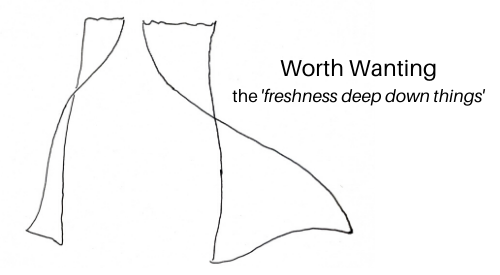
Encounters begin with a stance that quickly turns into a dance.
Encounters are occasions of making common cause with the livingness of an other or otherness, addressed as you. But common cause? How do that with, say, a book, or a city, not to mention any of the inner others like aspiration or heritage? (see Absent Others)
Common cause may evoke images of protests, marches, shoulder to shoulder standing firm.
These are vigorous and striking mental images. How do they apply to encounters?
The idea of coalition for the benefit of all is a better way to think of common cause. When I go walking in some quiet, green place, see someone coming and race them to get a face mask on, we’re making common cause, each saying to the other: we agree to keep you and ourselves safe.
Wearing a mask is a stance of solidarity with the other.
The foundation for making common cause is the conviction of parity between participants–each with a claim to existence as good as the other. The livingness of each is the concern of both.
But a stance of solidarity is not just a signal; it’s some particular kind of action that generates benefit. There are at least three general kinds of stances: hospitality, friendship and exploration.
A hospitality stance may, for instance, be expressed in teaching, nursing, healing, hosting, feeding, gifting, advising, protecting, listening, helping and so many more.
A friendship stance may involve activities like companioning, visiting, conversing, celebrating, sharing, commiserating and more.
In an exploration stance, we may engage in experimenting, learning, querying, noticing, researching, designing, creating, wondering and wandering…
For a fuller list, click here.
And as we encounter others in any of these modes we find our initial stance becomes a fluid interaction in which roles may shift or change.
I loved making this list (and there are many more activities I could have named) because these speak to the best and most interesting things we do. Not all are “pure,” of course; for instance, teachers should be paid. But the ultimate point, and I know this as a teacher, is the meeting of minds: I want to shape my material for the receptivity and risk-readiness (read livingness) of the student, and the student responsive to me as one who loves the subject.
In fact, truth be told, one of the most compelling arguments for me for the significance of encountering were the classes I had with different students that would kindle into occasions that we could almost feel as glowing faces at the close of class. What just happened, I would wonder to myself. That kind of occasion can’t just be over; it was too impressive, too intriguing, too intimate to simply cease.
Not all encounters are pleasant or gratifying as we all know. Learning can be hard, as can helping, as can witnessing. Also, an encounter may be one-sided. I may be more ready for freshness than you. They can take us by surprise when we recognize belatedly the ‘you-ness’ of the other.
Still the best way to get encountering is to make common cause by adopting a stance of solidarity with regard to an other, then to watch that stance become a dance, a graceful back and forth, over the course of a single encounter, or several episodes. It’s the point of being us.
